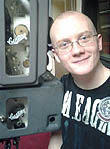|
|
 
|
|
Author
|
Topic: How do you check for scratching caused by your projector?
|
|
|
|
|
|
|
Leo Enticknap
Film God

Posts: 7474
From: Loma Linda, CA
Registered: Jul 2000
|
 posted 07-23-2014 12:43 AM
posted 07-23-2014 12:43 AM





To answer the question in the thread title, I shine a flashlight on both the base and emulsion side of the film as it comes out of the bottom of the machine, heading towards the take-up reel, as soon as possible after the changeover. If I see any scratch I then look at the film coming off the feed reel to check if it's there as well (unless I noticed the scratch when checking the reel on the bench, noted it in the condition report and therefore am expecting to see it). If it is, the scratch arrived on the print and there's nothing I can do about it. If it isn't, I've got a problem.
Thankfully, I've never been in the position of noticing a new scratch being inflicted while projecting to an audience, failed to find the cause or found that it can't be fixed without stopping the projector, and thus having stop the show or damage an entire reel.
| IP: Logged
|
|
|
|
|
|
Randy Stankey
Film God

Posts: 6539
From: Erie, Pennsylvania
Registered: Jun 99
|
 posted 07-23-2014 12:06 PM
posted 07-23-2014 12:06 PM




Considering what Brad says, check your pad rollers and sprockets and you should be good to go.
Wouldn't hurt to double check your trap alignment and tension, as well.
That kind of goes without saying...
As to how I would check a projector and film transport for scratching and damage issues, I start at the payout, follow the entire path through the system until reaching the takeup and just "be the film." If a roller doesn't roll the way it should, if a guide doesn't guide the film the way it should or if anything touches film that shouldn't, realign, repair or replace the offending part.
The concept is simple but the process is very detail-oriented but, as I said, just "be the film."
It sounds like you've done pretty well, so far.
Keep up the work and keep film alive! ![[thumbsup]](graemlins/thumbsup.gif)
| IP: Logged
|
|
Alastair Bowlie-Evans
Film Handler
Posts: 34
From: South Wales, Swansea
Registered: Jun 2014
|
 posted 07-24-2014 03:29 AM
posted 07-24-2014 03:29 AM




Oh dear--Think Ive been mis-understood.....
When I say 'light scratching' I mean--Just that. The surface is no longer shiny, checks with magnification indicate the surface both sides is equally dull, having thousands of tiny longditudinal marks, only noticable when the film is viewed at an angle to the light.
Sprocket-holes appear unaffected, although bound to be, but left me Electron Microscope in my other lab! ![[Big Grin]](biggrin.gif)
There is no obvious loss of emulsion or Loss of any of the Digital tracks.
If there Wasn't Light Scratching after 720 passes as described, then there would be something wrong!
By the action of Any Projector--There'll be this sort of wear. The Gate is the source, any flexible surface clamped between two other faces under spring-tension, accelerated and stopped 24 times a second will suffer Some form of wear This is Inevitable and unavoidable.
Another source of wear of this description could be the lay-on roller--which in this case clamps the edges of the film on the soundhead drum, Better than BAF/Kalee where its clamped on the Picture areas.....
Wear is defined as surface abrasion and scratching in this sorta scenario.
700 odd times through a clamped film-gate is bound to cause some wear like this.
What is the expected life of a print in passes through a machine? Ive heard 300 times quoted somewhere, but this does seem rather low....
Perhaps the word--Scratching is wrong for this description and the source of the confusion--Maybe I should have used 'Wear'....
The Philips FP-20/30 (kinoton) machines with their plastic curved gates I'm pretty sure are one of the kinder to film than something like a Cinemecclunker with its hardened steel gate and pressure-pads, guessing slight damage to the contact faces of one of those would wreck a digital track on one pass....
(This is just an observation, not saying that a Cinemeccanica isnt a good machine)
| IP: Logged
|
|
|
|
|
|
|
|
|
|
|
|
|
|
All times are Central (GMT -6:00)
|
|
Powered by Infopop Corporation
UBB.classicTM
6.3.1.2
The Film-Tech Forums are designed for various members related to the cinema industry to express their opinions, viewpoints and testimonials on various products, services and events based upon speculation, personal knowledge and factual information through use, therefore all views represented here allow no liability upon the publishers of this web site and the owners of said views assume no liability for any ill will resulting from these postings. The posts made here are for educational as well as entertainment purposes and as such anyone viewing this portion of the website must accept these views as statements of the author of that opinion
and agrees to release the authors from any and all liability.
|

 Home
Home
 Products
Products
 Store
Store
 Forum
Forum
 Warehouse
Warehouse
 Contact Us
Contact Us




 Printer-friendly view of this topic
Printer-friendly view of this topic










![[thumbsup]](graemlins/thumbsup.gif)
![[Big Grin]](biggrin.gif)

![[Razz]](tongue.gif)





